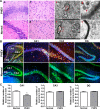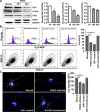Ulk1 Governs Nerve Growth Factor/TrkA Signaling by Mediating Rab5 GTPase Activation in Porcine Hemagglutinating Encephalomyelitis Virus-Induced Neurodegenerative Disorders
- PMID: 29875237
- PMCID: PMC6069187
- DOI: 10.1128/JVI.00325-18
Ulk1 Governs Nerve Growth Factor/TrkA Signaling by Mediating Rab5 GTPase Activation in Porcine Hemagglutinating Encephalomyelitis Virus-Induced Neurodegenerative Disorders
Abstract
Porcine hemagglutinating encephalomyelitis virus (PHEV) is a highly neurovirulent coronavirus and causes neurological dysfunction in the central nervous system (CNS), but the neuropathological mechanism of PHEV remains poorly understood. We report that Unc51-like kinase 1 (Ulk1/Unc51.1) is a pivotal regulator of PHEV-induced neurological disorders and functions to selectively control the initiation of nerve growth factor (NGF)/TrkA endosome trafficking. We first identified the function of Ulk1 by histopathologic evaluation in a PHEV-infected mouse model in which neuronal loss was accompanied by the suppression of Ulk1 expression. Morphogenesis assessments in the primary cortical neurons revealed that overexpression or mutations of Ulk1 modulated neurite outgrowth, collateral sprouting, and endosomal transport. Likewise, Ulk1 expression was decreased following PHEV infection, suggesting that there was a correlation between the neurodegeneration and functional Ulk1 deficiency. We then showed that Ulk1 forms a multiprotein complex with TrkA and the early endosome marker Rab5 and that Ulk1 defects lead to either blocking of NGF/TrkA endocytosis or premature degradation of pTrkA via constitutive activation of the Rab5 GTPase. Further investigation determined that the ectopic expression of Rab5 mutants induces aberrant endosomal accumulation of activated pTrkA, proving that targeting of Ulk1-TrkA-NGF signaling to the retrograde transport route in the neurodegenerative process that underlies PHEV infection is dependent on Rab5 GTPase activity. Therefore, we described a long-distance signaling mechanism of PHEV-driven deficits in neurons and suggested that such Ulk1 repression may result in limited NGF/TrkA retrograde signaling within activated Rab5 endosomes, explaining the progressive failure of neurite outgrowth and survival.IMPORTANCE Porcine hemagglutinating encephalomyelitis virus (PHEV) is a neurotropic coronavirus and targets neurons in the nervous system for proliferation, frequently leaving behind grievous neurodegeneration. Structural plasticity disorders occur in the axons, dendrites, and dendritic spines of PHEV-infected neurons, and dysfunction of this neural process may contribute to neurologic pathologies, but the mechanisms remain undetermined. Further understanding of the neurological manifestations underlying PHEV infection in the CNS may provide insights into both neurodevelopmental and neurodegenerative diseases that may be conducive to targeted approaches for treatment. The significance of our research is in identifying an Ulk1-related neurodegenerative mechanism, focusing on the regulatory functions of Ulk1 in the transport of long-distance trophic signaling endosomes, thereby explaining the progressive failure of neurite outgrowth and survival associated with PHEV aggression. This is the first report to define a mechanistic link between alterations in signaling from endocytic pathways and the neuropathogenesis of PHEV-induced CNS disease.
Keywords: NGF; Rab5; Ulk1; neurodegeneration; neurovirulent coronavirus; porcine hemagglutinating encephalomyelitis virus.
Copyright © 2018 American Society for Microbiology.
Figures







Similar articles
-
Porcine Hemagglutinating Encephalomyelitis Virus Triggers Neural Autophagy Independently of ULK1.J Virol. 2021 Sep 9;95(19):e0085121. doi: 10.1128/JVI.00851-21. Epub 2021 Jul 21. J Virol. 2021. PMID: 34287052 Free PMC article.
-
miR-142-5p Disrupts Neuronal Morphogenesis Underlying Porcine Hemagglutinating Encephalomyelitis Virus Infection by Targeting Ulk1.Front Cell Infect Microbiol. 2017 May 3;7:155. doi: 10.3389/fcimb.2017.00155. eCollection 2017. Front Cell Infect Microbiol. 2017. PMID: 28516065 Free PMC article.
-
Porcine Hemagglutinating Encephalomyelitis Virus Enters Neuro-2a Cells via Clathrin-Mediated Endocytosis in a Rab5-, Cholesterol-, and pH-Dependent Manner.J Virol. 2017 Nov 14;91(23):e01083-17. doi: 10.1128/JVI.01083-17. Print 2017 Dec 1. J Virol. 2017. PMID: 28956766 Free PMC article.
-
Biogenesis and function of the NGF/TrkA signaling endosome.Int Rev Cell Mol Biol. 2015;314:239-57. doi: 10.1016/bs.ircmb.2014.10.002. Epub 2014 Nov 18. Int Rev Cell Mol Biol. 2015. PMID: 25619719 Free PMC article. Review.
-
Retrograde transport of neurotrophins: fact and function.J Neurobiol. 2004 Feb 5;58(2):217-29. doi: 10.1002/neu.10322. J Neurobiol. 2004. PMID: 14704954 Review.
Cited by
-
Porcine Hemagglutinating Encephalomyelitis Virus Triggers Neural Autophagy Independently of ULK1.J Virol. 2021 Sep 9;95(19):e0085121. doi: 10.1128/JVI.00851-21. Epub 2021 Jul 21. J Virol. 2021. PMID: 34287052 Free PMC article.
-
Dipeptidyl peptidase 4 interacts with porcine coronavirus PHEV spikes and mediates host range expansion.J Virol. 2024 Jul 23;98(7):e0075324. doi: 10.1128/jvi.00753-24. Epub 2024 Jun 3. J Virol. 2024. PMID: 38829136 Free PMC article.
-
ULK overexpression mitigates motor deficits and neuropathology in mouse models of Machado-Joseph disease.Mol Ther. 2022 Jan 5;30(1):370-387. doi: 10.1016/j.ymthe.2021.07.012. Epub 2021 Jul 21. Mol Ther. 2022. PMID: 34298131 Free PMC article.
-
Neurological complications caused by SARS-CoV-2.Clin Microbiol Rev. 2024 Dec 10;37(4):e0013124. doi: 10.1128/cmr.00131-24. Epub 2024 Sep 18. Clin Microbiol Rev. 2024. PMID: 39291997 Review.
-
An Experimental Model of Neurodegenerative Disease Based on Porcine Hemagglutinating Encephalomyelitis Virus-Related Lysosomal Abnormalities.Mol Neurobiol. 2020 Dec;57(12):5299-5306. doi: 10.1007/s12035-020-02105-y. Epub 2020 Sep 2. Mol Neurobiol. 2020. PMID: 32876841 Free PMC article.
References
-
- Vijgen L, Keyaerts E, Lemey P, Maes P, Van Reeth K, Nauwynck H, Pensaert M, Van Ranst M. 2006. Evolutionary history of the closely related group 2 coronaviruses: porcine hemagglutinating encephalomyelitis virus, bovine coronavirus, and human coronavirus OC43. J Virol 80:7270–7274. doi:10.1128/JVI.02675-05. - DOI - PMC - PubMed
-
- Alsop JE. 2006. A presumptive case of vomiting and wasting disease in a swine nucleus herd. J Swine Health Production 14:97–100.
-
- Quiroga MA, Cappuccio J, Pineyro P, Basso W, More G, Kienast M, Schonfeld S, Cancer JL, Arauz S, Pintos ME, Nanni M, Machuca M, Hirano N, Perfumo CJ. 2008. Hemagglutinating encephalomyelitis coronavirus infection in pigs, Argentina. Emerg Infect Dis 14:484–486. doi:10.3201/eid1403.070825. - DOI - PMC - PubMed
-
- Mengeling WL. 1975. Incidence of antibody for hemagglutinating encephalomyelitis virus in serums from swine in the United States. Am J Vet Res 36:821–823. - PubMed
Publication types
MeSH terms
Substances
LinkOut - more resources
Full Text Sources
Other Literature Sources
Medical

